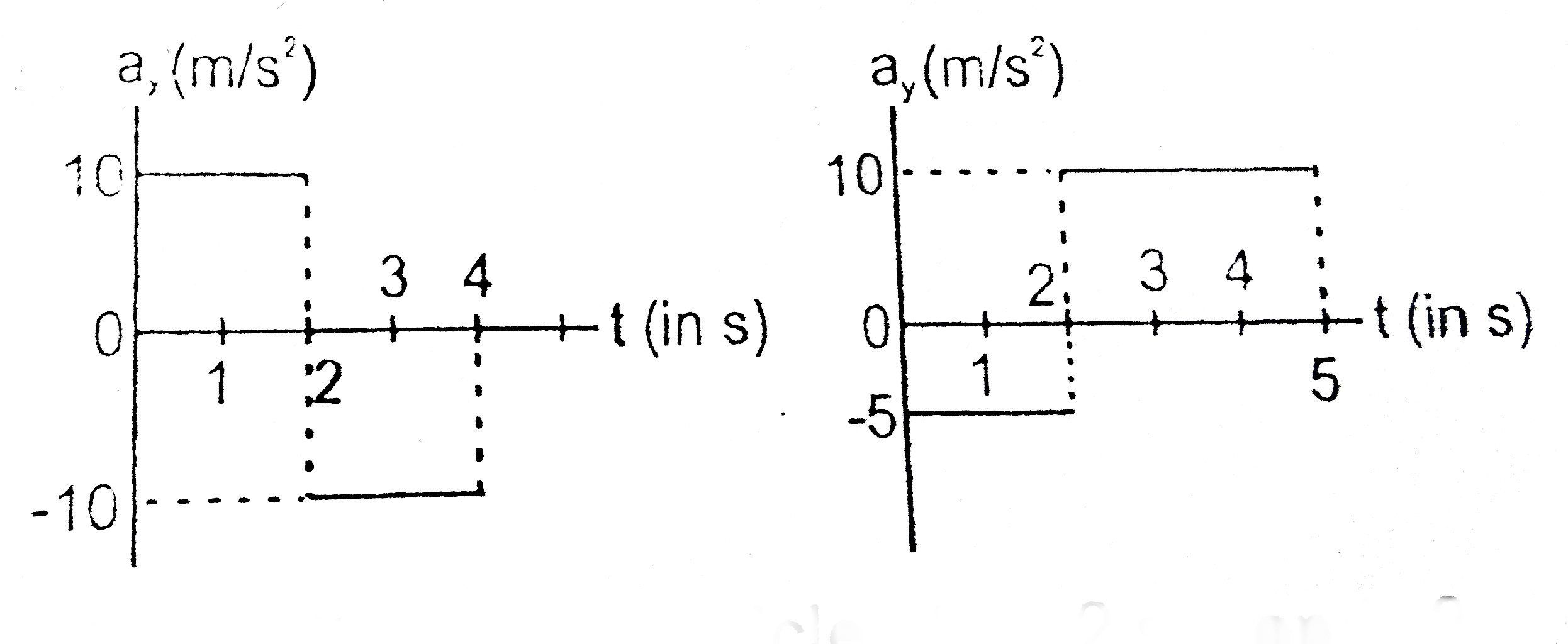A wheel which is initially at rest is subjected to a constant angular acceleration about its axis. It rotates through an angle of 15∘ in time t sec. Then how much it rotates in the next 2t sec
90∘
120∘
30∘
45∘
The correct Answer is:B
To solve the problem, we will follow these steps:
Step 1: Understand the problem
We have a wheel that starts from rest and undergoes a constant angular acceleration. It rotates through an angle of 15∘ in time t seconds. We need to find out how much it rotates in the next 2t seconds.
Step 2: Convert the angle to radians
First, we convert the angle from degrees to radians because the standard unit for angular measurements in physics is radians.
θ=15∘=15×π180=π12 radians
Step 3: Use the angular displacement formula
The angular displacement θ under constant angular acceleration is given by the formula:
θ=ω0t+12αt2
Since the wheel is initially at rest, ω0=0. Thus, the equation simplifies to:
θ=12αt2
Substituting the angle we found:
π12=12αt2
Step 4: Solve for angular acceleration α
Rearranging the equation to solve for α:
α=2θt2=2×π12t2=π6t2
Step 5: Calculate the angle rotated in the next 2t seconds
Now, we need to find the total angle rotated in 3t seconds and then subtract the angle rotated in the first t seconds.
Using the same formula for 3t:
θ3t=ω0(3t)+12α(3t)2
Again, since ω0=0:
θ3t=12α(3t)2=12α(9t2)=92αt2
Substituting α:
θ3t=92(π6t2)t2=9π12=3π4 radians
Step 6: Find the angle rotated in the next 2t seconds
Now, we subtract the angle rotated in the first t seconds:
θnext 2t=θ3t−θt
θnext 2t=3π4−π12
To subtract these, we need a common denominator:
3π4=9π12
Thus:
θnext 2t=9π12−π12=8π12=2π3 radians
Step 7: Convert the result back to degrees
Now, we convert 2π3 radians back to degrees:
θnext 2t=2π3×180π=120∘
Final Answer
The wheel rotates 120∘ in the next 2t seconds.
---
We have a wheel that starts from rest and undergoes a constant angular acceleration. It rotates through an angle of 15∘ in time t seconds. We need to find out how much it rotates in the next 2t seconds.
First, we convert the angle from degrees to radians because the standard unit for angular measurements in physics is radians.
θ=15∘=15×π180=π12 radians
The angular displacement θ under constant angular acceleration is given by the formula:
θ=ω0t+12αt2
Since the wheel is initially at rest, ω0=0. Thus, the equation simplifies to:
θ=12αt2
Substituting the angle we found:
π12=12αt2
Rearranging the equation to solve for α:
α=2θt2=2×π12t2=π6t2
Now, we need to find the total angle rotated in 3t seconds and then subtract the angle rotated in the first t seconds.
θ3t=ω0(3t)+12α(3t)2
Again, since ω0=0:
θ3t=12α(3t)2=12α(9t2)=92αt2
Substituting α:
θ3t=92(π6t2)t2=9π12=3π4 radians
Now, we subtract the angle rotated in the first t seconds:
θnext 2t=θ3t−θt
θnext 2t=3π4−π12
To subtract these, we need a common denominator:
3π4=9π12
Thus:
θnext 2t=9π12−π12=8π12=2π3 radians
Now, we convert 2π3 radians back to degrees:
θnext 2t=2π3×180π=120∘
The wheel rotates 120∘ in the next 2t seconds.
Topper's Solved these Questions
- ROTATIONBOOK - DC PANDEY ENGLISHCHAPTER - ROTATIONEXERCISE - Check point 9.2
20 Videos
- ROTATIONBOOK - DC PANDEY ENGLISHCHAPTER - ROTATIONEXERCISE - Check point 9.3
15 Videos
- ROTATIONBOOK - DC PANDEY ENGLISHCHAPTER - ROTATIONEXERCISE - (C) Chapter Exercises
39 Videos
- RAY OPTICSBOOK - DC PANDEY ENGLISHCHAPTER - RAY OPTICSEXERCISE - Integer type q.
14 Videos
- ROTATIONAL MECHANICSBOOK - DC PANDEY ENGLISHCHAPTER - ROTATIONAL MECHANICSEXERCISE - Subjective Questions
2 Videos
Similar Questions
A wheel initially at rest, is rotated with a uniform angular acceleration. The wheel rotates through an angle θ1 in the first one second and through an additional angle θ2 in the next one second. The ratio θ1/θ2 is:
View SolutionA wheel initially at rest, is rotated with a uniform angular acceleration. The wheel rotates through an angleθ1 in first one second and through an additional angle θ2 in the next one second. The ratio θ2/θ1 is :
View SolutionA disc initially at rest , is rotated about its axis with uniform angular acceleration . In the first 2 s, it rotates an angle θ . In the next 2s, the disc rotates through an angle
View SolutionA car wheel is rotated to uniform angular acceleration about its axis. Initially its angular velocity is zero. It rotates through an angle θ1 in the first 2 s. In the next 2 s, it rotates through an additional angle θ2, the ratio of θ2θ1 is
View SolutionA wheel is subjected to uniform angular acceleration about its axis. Initially, its angular velocity is zero. In the first 2sec, it rotates through an angle θ1, in the next 2sec, it rotates through an angle θ2. The ratio of θ2/θ1 is
View SolutionA wheel is subjected to uniform angular acceleration about its axis with its angular velocity is zero . In the first two seconds , it rotates through an angle θ1 and in the next two seconds , it rotates through an angle θ2 then the ratio of θ2/θ1
View SolutionThe wheel of a car, accelerated uniformly from rest, rotates through 1.5 rad during the first second. Find the angle rotated during the next second.
View SolutionThe wheel of a motor, accelerated uniformly from rest, rotates through 2.5 radian during the first second. Find the angle rotated during the next second.
View SolutionA stationary wheel starts rotating about its own axis at constant angular acceleration. If the wheel completes 50 rotations in first 2 seconds, then the number of rotations made by itin next two seconds is
View SolutionA particle which is initially at rest at the origin, is subjection to an acceleration with x− and y− components as shown. After time t=5 , the particle has no acceleration.

When is the particle at its farthest distance from the y− axis ?
A. 3 sec.
B. 2 sec.
C. 4 sec.
D. 1 sec.
View Solution